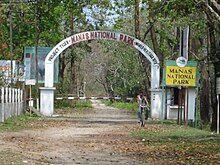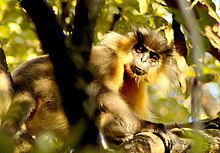Manas National Park
| Manas National Park | ||
|---|---|---|
| Manas National Park | ||
|
|
||
| Location: | Assam , India | |
| Surface: | 2600 km² | |
| Founding: | 1990 | |
The Manas National Park is located in the Indian state of Assam at the foot of the Himalayas ; it borders the Royal Manas National Park in Bhutan . The park is between 40 and 140 meters high and has an area of 50,000 hectares (500 km²). It forms the core zone of the Manas game reserve, which covers a total of around 2600 km². Together with the Royal Manas National Park in Bhutan (about 1000 km²) and the Jigme-Singye-Wangchuck National Park (about 1400 km²) to the north of it in Bhutan, the protected area covers 5000 km². The park is particularly known for its numerous endangered mammals, such as Asian elephants , bengal tigers , wild water buffalo , barasingha deer , golden langurs and pygmy boars .
history
The area was placed under protection on October 1, 1928 and declared a UNESCO World Heritage Site in December 1985 . Between 1988 and 1996 the park fell victim to political unrest, as a result of which the protected area was badly affected. A raid by armed Bodo separatists had largely destroyed the park's infrastructure. Numerous wild animals and trees fell victim to the rampant poaching. From 1992 to 2011 the park was placed on the Red List of World Heritage in Danger. In the meantime, however, the political situation in the area has stabilized again. The infrastructure in the park has been set up since 2003 and the number of visitors is rising steadily as a result.
Landscape and vegetation
Manas lies at the foot of the foothills of the Himalayas. The landscape ranges from alluvial plains to mountain ranges. The vegetation consists of semi-evergreen hill forests, wet and dry forests, and alluvial grasslands. The latter cover around 45% of the parking area. On the Bhutanese side, where the mountains reach up to 3000 m, there are also montane mountain forests.
fauna
Due to its location in the transition area between the Indian subcontinent and the Indo-Malay region, the park is home to a particularly diverse fauna. Manas is famous for its occurrence of endangered animal species, which are almost exclusively found here. These include the tiny pygmy boar , the bristle rabbit and the golden langur . The park is also home to many rare large mammals that have already disappeared in large parts of South Asia. The park is one of the few places where the wild form of the water buffalo can still be found. There are also Asian elephants, Indian rhinos and tigers. The last census in 2008 showed a total of 215 wild water buffalo in the reserve.
The populations of many animals in the park have been significantly reduced in the wake of the political unrest. The Indian rhinos , of which around 100 lived in the park area in the early 1990s, were almost completely exterminated between 1995 and 1996. Contrary to earlier speculations that assumed the species was completely wiped out in the park, however, around half a dozen of these colossi appear to have survived. Only in the last few years has the security situation stabilized to such an extent that rhinos can be resettled. In 2006, a three and a half year old female rhinoceros calf was first brought from Kaziranga to Manas, where it was temporarily located in a fenced area. More Indian rhinos from Kaziranga and Pabitora followed in 2007 and 2008, so that almost a dozen of the animals are now back in the Manas National Park. About 660 elephants were counted in the wider area of the park in 2005, most of which live in Manas National Park. This means that the park is still home to one of the largest populations of gray giants in all of India.
In addition to elephants and rhinos, the park is home to other very large mammals. In addition to the rare wild water buffalo, there is also the gaur , the largest wild cattle on earth. The park is also home to a tremendous variety of large predators and is home to one of the largest tiger populations in the country. In 2006, 61 King Tigers were counted. There are also Indian leopards , wild dogs , clouded leopards , sloth bears and black bears . The wolf also occurs on the Bhutanese side. Five species of deer live in the park: sambar , hog deer , spotted deer , Indian muntjac and the rare Barasinghas of which lived in the 1990s still about 450 in reserve. Wild boars , the rare dwarf wild boar and seraue (Bhutan) are other ungulate species. In addition to the rare golden langurs , the monkeys are represented by Assam macaques , rhesus monkeys , white-browed gibbons , cap langurs and slow loris . A rich variety of other smaller predators enriches the fauna of the area: Asian golden cats, Bengal cats , fish cats , reed cats , marble cats , Bengal foxes, yellow-bellied weasels , great martens , otters , Indian civets , Indian civets , spotted musangs , larvae rollers , binturos and binturos . Indian pangolins and flying squirrels also occur. Ganges dolphins live in the rivers of the park .
The bird world is as rich as the mammal world. Of the 450 species of birds that can be found in the park, about 350 breed in the area. This also includes numerous rare species such as the bearded bustard , the Bengal vulture , the narrow-billed vulture and the greater spotted eagle . The gavial is particularly striking among the around 50 reptile species .
literature
- Paramasivan, Jaya; Glimpse of Paradise: Manas Sanctuary ; 1993 (Publications Division, Ministry of Information and Broadcasting, Government of India)
Individual evidence
- ↑ William Riley, Laura Riley: Nature's Strongholds. The World's Great Wildlife Reserves. Princeton University Press, 2005. ISBN 0-691-12219-9 .
- ↑ a b c d e data sheet of the UNEP-WCMC ( Memento of the original from June 10, 2007 in the Internet Archive ) Info: The archive link was inserted automatically and has not yet been checked. Please check the original and archive link according to the instructions and then remove this notice. (English)
- ↑ Wild Cattle Conservation Project wildcattleconservation.org
- ↑ a b Status report 2006 of the World Heritage Committee (PDF; 742 kB), p. 45ff (English)
- ↑ Bibhab Kumar Talukdar: Asian Rhino Specialist Group report. Pachyderm 49, 2011, pp. 16-19 ( online )
- ↑ Vivek Menon, Rahul Kaul, Ritwick Dutta, NVK Ashraf and Prabal Sarkar: Bringing back Manas. International Fund of Animal Welfare 2008 ( PDF )
- ^ KK Gurung & Raj Singh: Field Guide to the Mammals of the Indian Subcontinent , Academic Press, San Diego, ISBN 0-12-309350-3
Web links
- Official website of the park
- Entry on the UNESCO World Heritage Center website ( English and French ).
- Data sheet of the UNEP-WCMC (English)
- Status report 2006 of the World Heritage Committee (PDF; 742 kB), p. 45ff (English)
- Rhinos released into the wild in Manas




